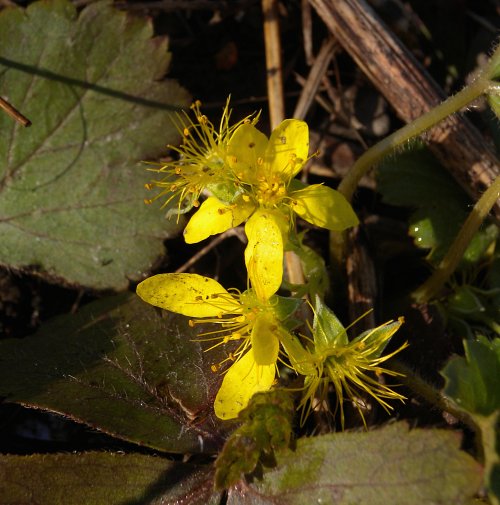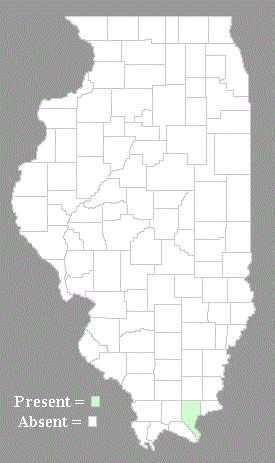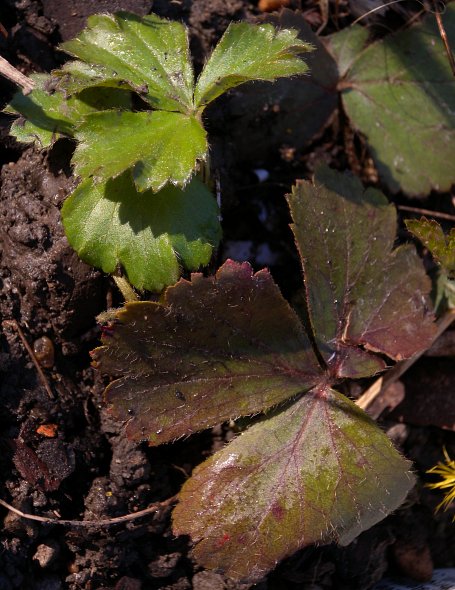
Occasionally, small cymes of 3-7 flowers are produced directly from the root system. These inflorescences are about as tall as the petioled basal leaves or a little taller. The peduncle, its branches, and pedicels of an inflorescence are light green, sparsely to moderately hairy, and rather slender. Narrow leafy bracts up to ½" in length occur where the branches of the peduncle and the pedicels diverge from each other. Pedicels of the flowers are up to ½" in length. Individual flowers are ½–¾" across, consisting of 5 yellow petals, 5 light green sepals that are joined together at the base, a dense ring of 40 or more stamens with yellow anthers, and a small central cluster of 2-6 carpels with slender styles. The petals are elliptic to broadly elliptic in shape and widely spreading; they are longer than the sepals. The sepals are sparsely to moderately hairy and deltate (triangular) in shape. The blooming period usually occurs intermittently from late spring to early summer, lasting about 1 month. The petals fall from the flowers after only 1 or 2 days. Afterwards, the carpels (pistils) mature into flattened achenes about 2 mm. in length. (one achene per carpel); these achenes are finely
 short-hairy. Prior to the
maturity of the achenes, the styles
break off from their achenes at the base. These styles lack hooks. The
root system has shallow reddish rhizomes and secondary fibrous roots.
Clonal colonies of plants of varying size are produced from the
rhizomes; this is the primary method of reproduction.
short-hairy. Prior to the
maturity of the achenes, the styles
break off from their achenes at the base. These styles lack hooks. The
root system has shallow reddish rhizomes and secondary fibrous roots.
Clonal colonies of plants of varying size are produced from the
rhizomes; this is the primary method of reproduction.Cultivation: The preference is partial sunlight to light shade, more or less mesic conditions, and soil containing rocky material, clay, loam, or humus. The soil pH should be moderately acidic to neutral (5.5–7.0). This plant dislikes hot summer weather and it requires some protection from the afternoon sun. In Illinois, areas with reduced competition from heavy leaf-fall and other ground vegetation are preferred.
Habitats: Barren Strawberry (Waldsteinia fragarioides) has been found only once in Illinois as a wild plant in Pope County, where it is regarded as a native wildflower. As a result, it has been listed as 'state-endangered.' Because this isolated population has not been relocated since its discovery, it is possible that Barren Strawberry has been extirpated from the state. The primary range of this wildflower occurs in the Appalachian Mountains and boreal areas of NE USA, the upper Midwest, and adjacent areas of southern Canada. In Illinois, this wildflower is most likely to occur in such habitats as sandstone or limestone ledges with thin layers of soil and humus, the rocky banks of woodland streams, and the rocky sides of wooded bluffs, especially if they face toward the north or east. So far, Barren Strawberry has occurred only in a high quality natural area of the state.
Faunal Associations: Very little is known about floral-faunal relationships for this wildflower. Andrenid bees (Andrena spp.) have been observed to visit the flowers for nectar and/or pollen (Krombein et al., 1979); it is likely that other small bees and other small insects visit the flowers as well. It has been reported that White-tailed Deer avoid browsing on the foliage (Hill, 2003).
Photographic Location: The wildflower garden of the webmaster in Urbana, Illinois.

Comments: The leaves of Barren Strawberry (Waldsteinia fragarioides) superficially resemble those of Wild Strawberry (Fragaria virginiana), but it produces dry achenes rather than colorful fruits and yellow flowers rather than white flowers. This native wildflower should not be confused with a very similar species that is often cultivated in ornamental gardens, namely the Siberian Barren Strawberry (Waldsteinia ternata). Many mass-market nurseries that claim to be selling the native Barren Strawberry are actually selling this latter species instead. The native Barren Strawberry differs from the latter species in the following ways: 1) its flowers have more narrow petals than the latter species, 2) there are no bractlets on its sepals, unlike the latter species, and 3) its leaflets are less deeply divided into lobes than the latter species. The light green bractlets on the sepals of Siberian Barren Strawberry are about one-third to one-half of the length of its sepals, and they are either linear or narrowly lanceolate in shape. Solitary bractlets occur between each pair of sepals. The petals of Siberian Barren Strawberry are oval to nearly orbicular in shape; adjacent petals on its flowers frequently overlap each other. Recently, some botanists have reassigned the native Barren Strawberry to another genus on the basis of genetic evidence. As a result, it is sometimes referred to as Geum fragarioides. Unlike most native Geum spp., however, the styles of native Barren Strawberry are neither persistent nor hooked. This means that animals and birds are unlikely to be important agents in the dispersal of its seeds. Another common name for this native species is Appalachian Barren Strawberry.